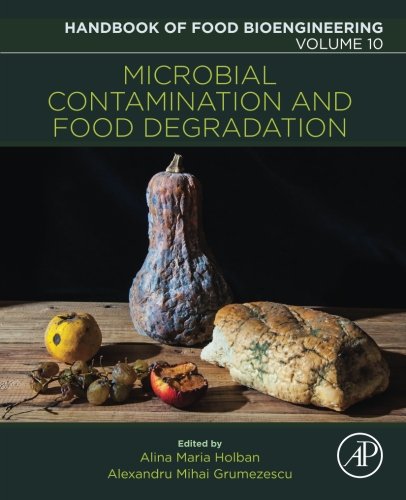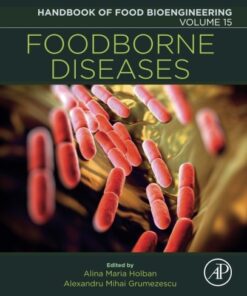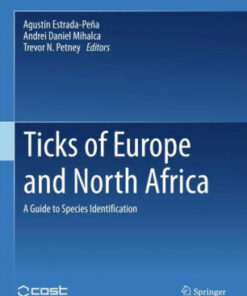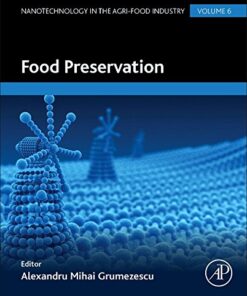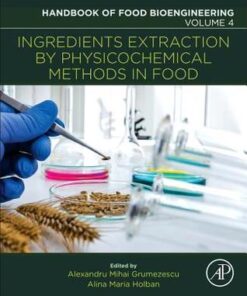(PDF) Microbial Contamination and Food Degradation By Alina Maria Holban
$22.00
Download instantly Microbial Contamination and Food Degradation By Alina Maria Holban, Alexandru Mihai Grumezescu. It is ebook in PDF format.
ISBN-10: 012811262X ISBN-13: 9780128112625
Preview
This is the PDF eBook version for Microbial Contamination and Food Degradation By Alina Maria Holban, Alexandru Mihai Grumezescu
Table of Contents
Foreword
Series Preface
Preface for Volume 10: Microbial Contamination and Food Degradation
Chapter 1: Food Products and Food Contamination
Abstract
1. Food Contamination
2. Types of Food Contamination
3. Types of Food
4. Contaminated Food Products
5. Entry of Pathogens Into the Food Supply
6. Summary and Conclusions
Chapter 2: Microbial Contamination, Prevention, and Early Detection in Food Industry
Abstract
1. Introduction
2. Bacterial Contamination in the Food Industry
3. Fungal Contamination of Food
4. Precaution Taken by the Food Industry to Prevent Microbial Growth and Contamination
5. Prevention of Microbial Contamination in Food Industry
6. Conventional Methods to Detect Food-Borne Pathogens
7. Rapid Diagnosis of Food Contamination
8. Conclusions
Chapter 3: Microbiological Contamination in Foods and Beverages: Consequences and Alternatives in the Era of Microbial Resistance
Abstract
1. Introduction
2. Deterioration and Contamination in Food Products
3. Other Food Products
4. Development of Microbial Resistant in Food Industry
5. Control of Pathogen and Spoilage Bacteria in Food Industry
6. Final Considerations
Chapter 4: Quorum Sensing as a Mechanism of Microbial Control and Food Safety
Abstract
1. Introduction
2. Biofilm Development
3. Bacterial Communication
4. QS and Biofilms in Food Safety
5. Resistance Mechanisms of Biofilms
6. Quorum Sensing and Its Control
7. Antiquorum Sensing Compounds Versus Antimicrobials
8. Future Needs
Chapter 5: Food Degradation and Foodborne Diseases: A Microbial Approach
Abstract
1. Microbial Epidemiology and History at a Glance
2. Microbial Food Spoilage: A Threat to Public Health
3. Factors Responsible for Food Degradation
4. Strategies to Avert Food Degradation
5. Methods for Identification of Food Degradation
Chapter 6: Fresh-Cut Fruits: Microbial Degradation and Preservation
Abstract
1. Introduction
2. Microbial Degradation of Fresh-Cut Fruits
3. Methods for Fresh-Cut Fruits Preservation
4. Modern Techniques
5. Innovative Techniques
6. Conclusions
Chapter 7: Occurrence of Natural Toxins in Seafood
Abstract
1. Introduction
2. Ciguatera Fish Poisoning
3. Tetrodotoxin Poisoning
4. Paralytic Shellfish Poisoning
5. Neurotoxic Shellfish Poisoning
6. Diarrhetic Shellfish Poisoning
7. Amnesic Shellfish Poisoning
8. Azaspiracid Shellfish Poisoning
9. Marine Toxins in the Production of Bioactive Compounds
10. Monitoring of Biotoxins
11. Impact of Climate on Marine Toxins
12. Conclusions
Acknowledgment
Chapter 8: Biopreservatives as Agents to Prevent Food Spoilage
Abstract
1. Biopreservatives
2. Essential Oils
3. Bacteriocins and Microorganisms
4. Enzymes
5. Final Remarks
Acknowledgments
Chapter 9: Wine Microbial Spoilage: Advances in Defects Remediation
Abstract
1. Introduction
2. Wine Microbial Spoilage
3. Current Methods for the Reduction of Volatile Acidity in Wines and Grape Musts
4. Role of LAB on Wine Safety and Quality
5. Preventive Treatments to Avoid Brettanomyces sp. Wine Contamination
6. Reduction of 4-Ethylphenol and 4-Ethylguaiacol Using Fining Agents
7. Prevention of Biogenic Amines Formation During Winemaking
8. Ethyl Carbamate Mitigation
9. Application of Fining Agents to Reduce OTA Concentration from Wine
10. Final Remarks
Chapter 10: Near-Infrared Spectral Informative Indicators for Meat and Dairy Products, Bacterial Contamination, and Freshness Evaluation
Abstract
1. Principles of Near-Infrared Spectroscopy
2. Application of NIR in Determination of Meat Freshness and Bacterial Contamination
3. Application of NIR in Meat Quality Identification
4. Application of NIR for Quantitative Analysis, Bacterial Contamination, and Disease Diagnosis in Dairy Products
5. Conclusions
Chapter 11: Use of Bacterial Growth Curve for Assessing Risk of Microbiological Pathogens in Food Products
Abstract
1. Introduction
2. Cases Found in a Developing Country Due to the Implementation of the “Zero Tolerance” Concept
3. Bacterial Growth Factors and Curve
4. Application of the Bacterial Exponential Growth Equation for the Microbiological Pathogenic Risk Assessment Model
5. Development of Food Standard for Pathogen
6. Application of the Microbiological Pathogenic Risk Assessment Model for Food Standard Establishment
7. Conclusions
Chapter 12: Biosensors and Express Control of Bacterial Contamination of Different Environmental Objects
Abstract
1. Introduction
2. The Most Common Foodborne Pathogens
3. Antibiotic Resistance of Pathogens
4. Traditional Methods for Microorganism Detection
5. Biosensors for Detection and Control of Pathogenic Microorganisms
6. Conclusions
Acknowledgments
Chapter 13: Mycotoxins in Foods: Mycotoxicoses, Detection, and Management
Abstract
1. Introduction
2. Fungus Associated With Mycotoxin Production
3. Detection of Mycotoxins in Foods
4. Management of Mycotoxins
5. Conclusions
Chapter 14: Multiple-Locus Variable-Number of Tandem-Repeats Analysis as Subtyping Technique for Food-Borne Pathogens
Abstract
1. Introduction
2. VNTRs Stability
3. Conclusions
Chapter 15: Antimicrobial and Antioxidant Properties of Essential Oils in Food Systems—An Overview
Abstract
1. Introduction
2. Spices and Herbs
3. Essential Oils
4. Antimicrobial Properties
5. Antioxidant Properties
6. Perspectives
Index
